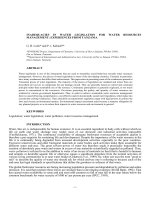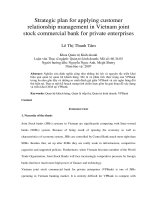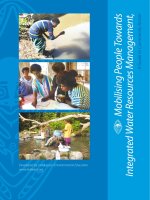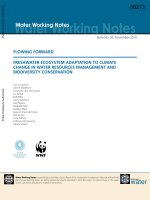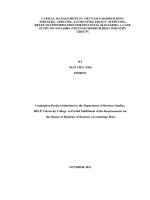Water resources management in Vietnam
Bạn đang xem bản rút gọn của tài liệu. Xem và tải ngay bản đầy đủ của tài liệu tại đây (248.92 KB, 20 trang )
Water Resources
Management in Vietnam
Tasks and Roles of water resources
management department, Vietnam
The Department of Water Resources Management
(DWRM) has Functions to provide assistance to the
Minister in implementing state management on
water resources including rain water, surface water,
ground water, and sea water within the territorial
land and sea of the Socialist Republic of Vietnam.
Powers and Responsibilities of DWRM
1. Develop legal documents, policies, strategies, planning, long-term, 5year and annual
plans, programs,
2. Develop processes, procedures, standards, technical-economic norms
on water resources
management
3. Submit to the Minister for approval on assignment and delegation in
basic investigation on
water resources;
4. Develop measures on protection of water sources, control of and
prevention against water resources deterioration and pollution
5. Compile data, manage results of basic investigations, inventories and
assessments of water resources; develop national water resources
database and information exchange system
Powers and Responsibilities of DWRM
(next)
6. Submit to the Minister to define authorities and procedures on
issuance, extension, revoke licenses on surveying, exploration,
exploitation and utilization of water resources, and waste water discharge
permits;
7. Appraise projects and works in areas of water resources basic
investigation, planning, plans and projects related to protection,
exploitation, utilization and development of water
resources
8. International cooperation in water resources areas
9. Implement function as Office of National Water Resources Council
(NWWRC) was established to advise the Government of Viet Nam on
issues related to water resources required Government’s approval.
10. Inspect and deal with claims, denunciations and disputes on water
resources
Water resources status in Viet Nam
• Annual average Rainfall (Xo) 1,960 mm
• Total annual discharge of all rivers is about 840-850.109 m3,
incoming flow volume from outside is 500-510 109 m3, total
flow volume generated inside is about 340 109 m3 (40%).
• The Mekong River's total runoff accounts for 59% of the total
national runoff, followed by the Red River with 14.9%.
• VN has about 2,378 rivers over 10 km long which have a
perennial flow, and 15 basins with an area of more than 2,500
km2 of which 10 river basins are of over 10,000 km2 in area.
These account for 80% of the total area of Vietnam.
Main river systems in VietNam
Basin over 10.000 km2
Basin 2.500 – 10.000 km2
Bang Giang - Ky Cung
Thach Han
Hong (Red) and Thai binh
Huong
Ma
Tra Khuc
Ca
Kone
Vu Gia - Thu Bon
Gianh
Ba
Srepok
Se San
Dong Nai
Cuu Long
The density of Water Utilization of 9 major
river basins in Viet Nam
The density of Water Utilization of 9 major river
basins in Viet Nam (continue)
The density of Water Utilization of 9 major
river basins in Viet Nam (continue)
Water resources Management in Viet Nam
In the past:
- Promote of water demand
- Investment focus on water resources infrastructures
development
Present: Management of water utilization requirement: include
of:
- Water quality management
- Water quantity management
Legal documents on water resources
- The law on water resources(20/Aug/1998)
- Secondary legal documents:
• The Decree on stipulating the implementation of the law on
water resources (30/Dec/1999)
•The Decree on Water resource information management
(19/Dec/2003)
• The Decree on Licensing for exploitation, utilization, use and
discharge waste water (27/july/2004)
• The Decree Integrated river basin management (submitting)
• The Decree on sanctions against administrative violations of
water resources management regulations (17/march/2005)
•The National strategy on water resources to 2020 (14/Apr/2006)
•…..
Challenges and Proposed measures on
IWRM
There are still many shortcomings in terms of planning, management,
utilization and protection of water resources in comparison with country
development needs
A number of water-related challenges have increased in recent times, water
quality is deteriorating in many areas due to urban and industrial activities and
saline water intrusion is increasing as dry season river flows are reduced, local
and seasonal shortages are increasing, causing impacts on water users and
environment.
The recently established DWRM operating in a complex policy environment
attempting to bring a strategic approach to water resource management but has
limited experience in development policy and planning activities for water
resources
Proposes
National Water Resources Strategy
National goals for water
Water resource economics tools to river basin planning; policy development,
and water resource protection, management and allocations, etc...
Background, issues, challenges
(next)
Issues, challenges
- Population increasing and Industrialization
- Policies and secondary legislation under the Law on Water Resources are
not complete. the capacity to develop strong policy and secondary legislation
is limited.
- Some overlap of responsibilities among Government’ Agencies.
- Lack of integrated river basin planning and management
- Low Institutional and capacity
- Ineffective in Inspection and enforcement and conflict resolution activities.
- Water resources data and information is still scatted, Monitoring networks
are insufficient, data quality is not high
- Level of awareness, skills and technology for integrated water resources
management fairly low at both the national and provincial level.
- Budget for water resources development and management is limited and has
not met the demand of the sector.
- Lack of long term financial strategy including state budget, international
assistance, private investment and using fees.
Vision and concrete action
- Developing National Strategy for Protection and Sustainable Development of
Water Resources of which the National Goals for Water Resources is one of the
leading component of the National Strategy.
- Inventory appraisal for Water resource
- Review and update the Law on Water Resources other By-law to create legal
corridor for water resources management.
- Priority policy in the water sector
- Developing and upgrading water Resources monitoring network
- Integrated river basins planning and Management,
- Long term financial investment strategy
- Information exchange network among the water resources coordination and
management agencies for international rivers.
- Water resources information system and provide timely and accurate
information for the water resources users.
- Effective operation of water resources inspection.
Achievements
- Legal documents on water resources management
- Development of National water profile
- International cooperating on water resources with many other
countries and international organizations such as: China, Norway,
Australia,... ADB, World Bank,...; Participating on Mekong river
Commission; Development of water quality rules on Mekong river
- Participation of people on water resources protection
- Scientific and technological research has been conducted in the field
of water resources
- Development of water resources monitoring network
- Investment on water resources management such as: improvement of
water quality in some main rivers; application of technology on
production.....
Achievements (cont)
Water development works: such as:
Catchments
(km2)
Volume
(bill.m3)
Hoa Binh
51,700
9,450
1,920
Thac Ba
6,100
2,940
108
Tri An
14,600
2,760
4200
Dau Tieng
2,700
1,580
Thac Mo
2,200
1,370
150
Yaly
7,455
1,037
720
Phu Ninh
235
414
Song Hinh
772
357
Ke Go
223
345
Reservoir
Irrigated
Area (ha)
Hydropower
(MW)
72,000
23,000
66
17,000
Priority order action plans
(according to National strategy on water resources to 2020)
1. Program of national water resources inventory, assessment and
development of water resources database, information system.
2. Program of water resources sharing (priority for domestic water) and
ensuring of power generation for the important hydropower works in drought
case
3. Program of water resources allocation and regulation for ensuring security
of water resources for water scarcity provinces
4. Program of plants structure conversion for utilizing effectively water
resources
5. Program of development of inter-reservoirs regulations in these important
river basins
6. Program of ground water protection in the major cities
Priority order action plans
(according to National strategy on water resources to 2020)
7. Program of implementation of water service socialization, development of
the multi-sectors water economic for matching the market economic and
socialist orientation
8. Program of protection of the valuable aquatic species
9. Program of definition and ensuring of environmental flow, maintaining
aquatic ecosystems for reservoirs, water resources, water works.
10. Program of protective forests reservation and recovery in these river basin
of the major reservoirs
11. Program of development of hydropower reservoirs management
mechanism for developing the economic, tourism, environment protection and
for improving people life around reservoir entrails
Priority order action plans
(according to National strategy on water resources to 2020)
12. Program of bilateral cooperation with these neighbor countries in water
survey; water resources information and data sharing; trans-boundary water
protection, utilization and exploitation
13. Program of dykes-ocean, dykes-estuary systems consolidation,
upgrading and modernization.
14. Project of water resources law reform
15. Program of economic instruments on water resources management
16. Program of water resources education, communication and awareness
17. Program of compilation of water resources education, training for school
18. Program of the whole people in participating water resources protection
